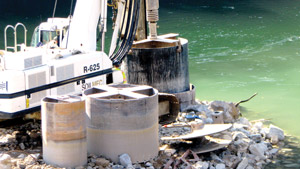Drilling Fluids
Drilling Fluids: Head Pressure Key to Drilled Shaft Stability
The use of drilled foundations is a growing technology nationwide that provides a reliable long lasting solution. More recently, a trend has developed among architects, engineers and owners pushing for larger diameter and longer drilled shafts to be installed. In lieu of this trend, we have also seen an increase in slurry-displaced shafts. Whether you choose a mineral slurry or a synthetic slurry for your application, hydrostatic head pressure is a key element in maintaining shaft stability. Hydrostatic head is defined as “the pressure at a given point in a liquid measured in terms of the vertical height of a column of the liquid needed to produce the same pressure.” In other words hydrostatic head pressure is the pressure slurry exerts to combat the natural formation pressure of the earth and groundwater.

|
| A rig uses a rock coring bit to drill a shaft for the North Fork White River Bridge in Arkansas. Proper slurry technique is critical for larger, deeper drilled shafts, particularly when a project involves a high water table. Source: Arkansas Highway and Transportation Department |
Pressures are forces and are prevalent in our everyday lives, even though we may not always recognize them. In fact, atmospheric pressure is always being exerted on our bodies and everything around us. The same holds true each time we drill a shaft. There are many different pressures involved and, in order to be successful, we must balance and/or counteract the pressures at hand with an equal or greater force.
In a normal non-slurry displaced shaft construction (dry shafts) we have several forces that must balance. The first of which is formation pressure. Formation pressure can be described as the formation’s natural tendency to seek the path of least resistance, which, in terms of a drilled shaft, is the area of excavation. The second force at work is the cohesive bonds between soil particles. If the formation pressure is greater than the cohesive bonds, then the shaft will collapse. If inversed, the shaft should remain stable.
As the industry trends toward larger, deeper shafts the frequency of dry shafts diminishes. The deeper the shaft is drilled, the greater our chances are of encountering groundwater. Groundwater introduces a new pressure to the matrix. We can also make the inference that if groundwater is present we likely have more porous soil conditions, indicating less cohesion between particles. For these reasons, fluid pressure inside the shaft is often required to stabilize the excavation. This is where slurry comes into play.
Slurry works by increasing the pressure inside the shaft to exceed the formation pressure without seeking the path of least resistance and flowing into the porous soil. The difference between the groundwater elevation and slurry elevation creates hydrostatic pressure within the shaft. The difference between the groundwater elevation and the slurry elevation is called the hydrostatic head. We can calculate the hydrostatic head pressure using a simple formula:
Hydrostatic pressure = 0.052 x slurry density (lbs/gal) x depth (ft)
The hydrostatic head pressure required to maintain the excavation depends on a number of factors. Geological conditions, type of slurry used, groundwater elevation, water salinity and tidal influences all determine the amount of head pressure required. Consult your slurry manufacturer for help in determining the appropriate head pressure requirements for your project.
One of the most common problems encountered in the field is the failure to account for Kelly bar, tool and spoil displacement. The hydrostatic head pressure must be maintained at all times at the level determined by the slurry manufacturer. Even though you may have the recommended amount of hydrostatic head before the Kelly and tool are removed, after removal the slurry level will inevitably drop. This can be especially pronounced in small diameter shafts. Reduction in head pressure can compromise the stability of the shaft, causing sloughing of the bottom and sidewalls. To prevent this, increase your head pressure to account for the calculated displacement of your machine and tooling. If needed, top steel casing can be extended above ground to help compensate for the additional head pressure. Overflow cans are also a common way of containing excess slurry that may be displaced when inserting the tooling.
Another common mistake when dealing with slurry is the misinterpretation of groundwater elevation. Groundwater fluctuates greatly based on seasonal precipitation and many other elements. It is important to take note of actual groundwater elevation before introducing slurry. Boring logs provide a general reference as to the estimated groundwater levels. It is important to take note of what time of year the borings were completed and also how long ago. Often, borings are done years before the project breaks ground. Groundwater conditions and even elevations can change significantly in this time period. Elevation changes are most often due to changes in project working gradeand/or erosion.
In coastal locations the presence of salt water and tidal influence are another problem often overlooked. Salt water has roughly three percent greater density than that of fresh water. Therefore, we must increase our fluid pressure by placing additional head pressure on the shaft. Consult your slurry manufacturer for water testing and head pressure recommendations. Tidal influences also add complexity to slurry displaced drilled shafts. It is critical to make note of high and low tide elevations. In these circumstances, head pressure must be adjusted based on time of day to maintain the recommended minimum level.
Understanding the importance of head pressure is essential to producing a quality product. Leveraging the expertise of your slurry manufacturer before during and after the job will help you make crucial decisions and prevent costly mistakes. In the words of Benjamin Franklin, “by failing to prepare, you are preparing to fail.”
Looking for a reprint of this article?
From high-res PDFs to custom plaques, order your copy today!

